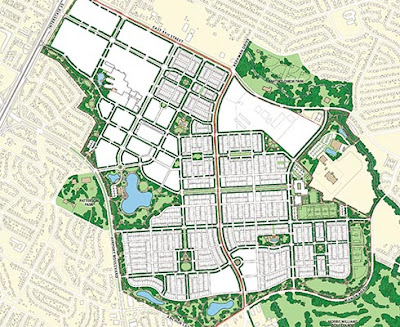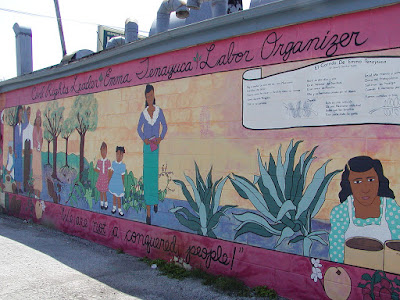Twenty Minutes in Mueller: New Urbanism, Austin, and Ruminating on the City Liberated
I've always been drawn to ruminations
on the cities that I've lived in, their patterns and cycles. How one
feature makes one city so much more livable than another. How
another makes it a nightmare. The weird transformed Austin of my
childhood, car-culture imprisoned Arlington Texas and Phoenix, the
strange two-city feel of San Antonio, the desperate ruins of Detroit
have all been so starkly different that I can't help but get caught
in the comparisons—and in impossible dreams of what cities might
look like if they were transformed and liberated.
Knocking doors 6-7 days a week for an
extended period of time—as I have in this election cycle--also starts to
give you a certain intimacy with the city that you just don't get any
other way. You feel the rhythms of people coming and going, get
minute-by-minute glimpses in how they lead their lives, and gain an
immediate knowledge of just how walkable and livable their
neighborhoods are.
The majority of the last month has
been spent working a long arc of eastern Travis County, the
neighborhoods of working class people of color pushed way out to the
geographical margins by gentrification and the merciless Austin
housing market. The sheer diversity of those neighborhoods almost
defies description. There is the working class, fresh clean
sidewalked suburbia of parts of Del Valle sitting next to pre-fab
industrial housing developments. There is the rural poverty feel
chaos of a sprawling trailer park off Johnny Morris and the old
established, the massively encroached areas of the traditional black
community off Rosewood and the apartment wastelands of far Riverside.
And over all of it is the stark
contrast of laying my head down each night in comfortable Mueller,
the star jewel of new urbanist redesign that transformed Austin's old
airport. Mornings and evenings spent walking the long parks, around
the aching beauty of the new lakes and metal and
mosaic-tiled sculptures. Ducking in for a pint and strolling under a
faerie-land of balloons and light-wrapped trees. One day eating bao
and catching a matinee, the other just strolling and feeling wistful as you the notes of a brass band float over the lake from the refurbished hangar.
It's hard not to love it some and even
imagine the better world that a democratic socialism controlled from below might
have for re-imagining cities in its emphasis on walkability,
nurturing conviviality/social connection, and its intentional public
space most of all with its farmers markets, fitness classes in the
park, semi-public communal parks, pocket parks, etc.
But...
Of course we live in capitalism and the
aggressive metasized version of post-millennial America in particular. A lot of "on
the other hand" stalks the fresh clean lines of these streets. It's
hard not to notice not just the absurd housing prices and rents in an already absurdly
priced city (for Texas) but the nagging insularity of it as an outlier in the old
black and brown core neighborhoods all around it.
Architectural critic Michael Sorkin
takes on new urbanism from the left in his magnificent book Twenty
Minutes in Manhattan and helps
nail the nagging thoughts I have on these walks:
“...the focus of the new urbanists is the suburbs, and their critique is telling, if not exactly original. They anathematize the alienations and inefficiences of sprawl, savage the ugliness of the strip, call for remaking the suburbia in the image of a town. Across the country, they have successfully persuaded hundreds of developers to reformat their templates to create, denser, neo-traditionally styled “neighborhoods.” But they have done almost nothing to transform the ecology of suburbanism, to revise its social and economic space. The overwhelming majority of new-urbanist projects retain the almost purely residential, exclusively middle-class character of suburbia, simply substituting one formal paradigm for another. Instead of curving streets, cul-de-sacs, and half-acre lots, these developments offer grids, tightly-spaced houses with front porches, and a town center instead of a shopping center containing the very same shops.
“...the focus of the new urbanists is the suburbs, and their critique is telling, if not exactly original. They anathematize the alienations and inefficiences of sprawl, savage the ugliness of the strip, call for remaking the suburbia in the image of a town. Across the country, they have successfully persuaded hundreds of developers to reformat their templates to create, denser, neo-traditionally styled “neighborhoods.” But they have done almost nothing to transform the ecology of suburbanism, to revise its social and economic space. The overwhelming majority of new-urbanist projects retain the almost purely residential, exclusively middle-class character of suburbia, simply substituting one formal paradigm for another. Instead of curving streets, cul-de-sacs, and half-acre lots, these developments offer grids, tightly-spaced houses with front porches, and a town center instead of a shopping center containing the very same shops.
Although at one level these
developments seem to embody the [Jane] Jacobs writ, just beneath the
bright surface they are its antithesis. With their monochrome
styling, restrictive covenants, and homeowners associations, these
places are bulwarks against deviancy.”
Mueller isn't the worst offender here
in Sorkin's criticism but it substantively holds. It's not the
socialist city of the future, Red Vienna, or even the stop-gap urban
planning we need to realize the slogan of DSA comrades I find myselfrepeating over and over in my day on doors “housing is a human right.”
Austin has a small start and those of
us here have the fortune of being able to fight here and now for a
not tiny step in Proposition A that will allocate $250 million to a
bond ($100 million itself to be the buying up of land by the city for
redevelopment of low and mid income housing).
I think it's worth experiencing and
dreaming over the specific forms of what we want in the urban
experience. I can still savor my walks and explorations for what they
are and luxuriate in dreams of it being spread all across cities. But
of course that leads to politics of the little “p” the struggle
of social movements that we so desperately need. It takes continued
fight and continued dreaming. The constant struggle and ferment from
below just to hold on to that and make it worthwhile.
[To plug in to the fight for housing in the Austin one can click right here. More info on Prop A can be found here.]








Comments
Post a Comment